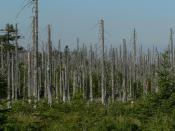Within the last decade acid rain has become an environmental concern of global importance. Acid Rain is rain with pH values less that 5.6. The acid consists of sulfur and nitrogen compounds that are produced naturally by the decay of organic matter in swamps, wetlands, intertidal areas, and shallow waters of the oceans. The amount that is contributed to the atmosphere from these sources is not known for sure but is quite large. Estimates of naturally produced sulfates and other sulfur compounds are from 35 to 85 percent of the total produced with naturally occurring nitrogen compounds believed to be 40 to 60 percent of the total. The contribution of lightning to the acidity of rain is significant. Two strokes of lightning over one square kilometre produce enough nitric acid to make four-fifths of an inch of rain with a pH of 3.5.
Industrial activity, transportation, and burning fossil fuel for commercial and domestic purposes all contribute sulfate, nitrates, and other pollutants to the atmosphere.
As sulfur dioxide emissions decrease, nitrogen emissions are increasing, mainly from oil burning and the oil used in transportation.
Industrial society also produces other air pollutants, including volatile organic compounds, ammonia, and hydrocarbons. Any of these may contribute to the formation of acid rain.
The effects of acid rain can be very serious. Researchers now know that acid rain causes slower growth, injury, or death of forests. Acid rain does not usually kill trees directly. Instead, it is more likely to weaken trees by damaging their leaves, limiting the nutrients available to them, or exposing them to toxic substances slowly released from the soil. Acidic water dissolves the nutrients and helpful minerals in the soil and then washes them away before trees and other plants can use them to grow. At the same time, acid...


